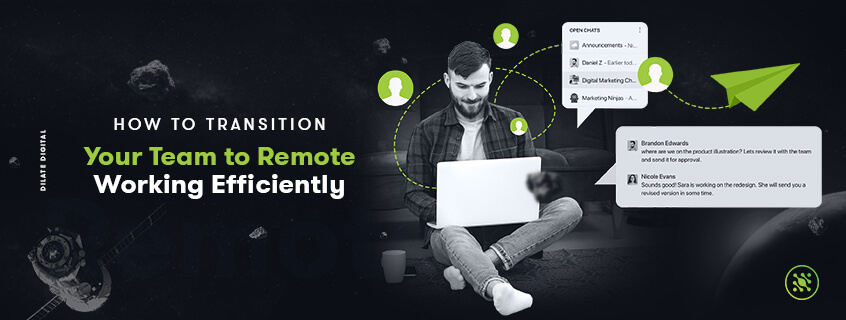

In only a couple of months, COVID-19 has had a massive impact on the way we live and work. Many businesses have started asking their staff to work from home in a bid to reduce their contribution to the spread of the Coronavirus. For some, this transition to remote working might be a natural one, but for others it is a daunting task, especially given the time pressure. At this time of uncertainty, many questions weigh on the minds of both employers and employees alike. Questions like ‘what does working remotely mean?’ and ‘is working remotely a good idea?’ As a digital marketing agency, many of our team members work remotely in our normal business operation and now the rest of our staff are working from home also. We’ve made the switch and so we understand the challenges - technical and personal - that come with transitioning to remote work. Whether you’re a business owner or employee, we’d love to share our knowledge with you so you can make your transition to remote work as smooth and successful as possible. Working remotely means you don’t clock in at a physical office, you don’t make the commute home: you work wherever you have a sturdy internet connection. Even before COVID-19, remote working was actually becoming more popular than ever. The business world is increasingly moving towards doing things online and more businesses are investing in things like quality digital marketing and online operating systems. Whether you’re trying to figure out how to work remotely as a web developer, accountant, insurance agent or customer service officer, there are increasingly more types of jobs that allow working remotely. Some jobs will transition easier than others, but with the right tools and company culture, it’s incredible how remote working can actually benefit businesses. Now for some pragmatic and practical solutions that you can use to get started with the transition to remote work in your own business. The first section is for employers, the second for employees.
 Some companies have experience with remote working, but others might be diving into it for the first time. When you’re not given much time to make the transition, it’s important that you know the core aspects of how to work remotely. Here is our (tried and true) advice for how to manage employees who work remotely:
Some companies have experience with remote working, but others might be diving into it for the first time. When you’re not given much time to make the transition, it’s important that you know the core aspects of how to work remotely. Here is our (tried and true) advice for how to manage employees who work remotely:
Without a physical office space, your teams will need online platforms to work in and collaborate with each other. The type of tools that will be most effective for your teams will depend on your specific needs. At Dilate we use Asana for project management, Google Drive for file sharing and Foxy Proxy to connect and use Dilate's dedicated IP address, just name a few. Whatever tools you decide to use, the key thing is to pick a core set and make sure your employees are comfortable navigating them. Too many tools will overwhelm your teams and may even reduce productivity. Also, try not to get multiple tools that achieve the same purpose. Instead, streamline the tools you use to make the transition smoother and more accessible for everyone. The good news? More and more businesses are turning to online tools which means there are a whole range of top-quality ones out there making transitioning easier than ever. Although you might be implementing these changes to get through the next few uncertain months, you might find that some of these online tools benefit your business in the long run.
We all know that clear communication within your team members is essential for getting stuff done. So once you’ve set up online spaces for your teams to work in, you’ll need to choose some tools so they can talk with each other. At Dilate, we use Slack, but other popular communication tools include Discourse and Mattermost. Whatever you choose, follow the same principles outlined in point #1. That means streamlining your tool selection to keep things accessible and simple. Then think about creating 3 levels of communication within your chosen tool:
Consider also creating channels which are purely social and can help build relationships between team members. Afterall, remote work means no more watercooler moments. You can help facilitate the social bonding of your team members by providing online spaces for them to connect. When you have meetings, using video calls can help make your teams feel more connected. While the majority of your company communications might be through direct messaging, video calls have the benefit of body language and facial expression. It can feel much more personal, and provide that face-to-face contact that many team members might be craving. Two solid tools for video calls that we use at Dilate are Skype and Google Hangout.
Transitioning to remote working is going to be a first for a lot of your employees. You’ll probably be introducing them to a number of new tools and expecting them to restructure the way they work. While some of your staff might be excited by the idea of working from home, it could cause a lot of anxiety for others. Don’t leave your team hanging during the transition. Make them feel supported by providing orientation and training. Start with a remote webinar and accompanying handbook that covers the key topics in this article such as:
Consider starting a ‘help’ channel where your employees can feel safe to ask their questions about remote working. This will be good for general and technical help, but you should also make sure your staff know where to go if they are facing more private and personal issues.
One of the big challenges of remote working is making your employees feel like they’re still in the loop. Employees that feel disconnected and out of touch have a difficult time staying motivated and positive. So it’s important to make sure all your employees are kept informed about company news. Think: updates, announcements and changes, as well as celebrating the wins when you hit company goals and recognising teams and projects that are doing well. This in particular is more important than ever. There are many ways to keep your staff informed such as an internal company blog, regular staff webinars and updates via the company-wide channel on your communication tool. Encourage others to respond to the news and updates, and open up the space for different teams to share their own news.
Let’s back up for a sec and just acknowledge that transitioning to remote working isn’t easy, especially under the external pressure of something like COVID-19. Everyone is going to respond differently, and as an employer, you should be prepared for some bumps in the road. Accepting this is an important step. From there, you can put in place strategies for better navigating the adjustment period. When figuring out how to get through these tough times, keep these key principles in mind:
 So you’ve been asked to work from home. If this is completely new to you, it might be a bit overwhelming or even down right stressful. How do you avoid distractions? How do you manage family expectations? How do you work remotely without losing motivation? We get it. Working remotely might be right up some people’s alley, but it’s a massive hurdle for others. Wherever you fall on the spectrum, the key is to know yourself and be intentional about creating an environment that sets you up for success. It will take some adjusting, but the good news is that once you establish a good relationship with it, remote working can help you feel in-control and empowered. These are our core tips for helping you navigate how to work remotely from home:
So you’ve been asked to work from home. If this is completely new to you, it might be a bit overwhelming or even down right stressful. How do you avoid distractions? How do you manage family expectations? How do you work remotely without losing motivation? We get it. Working remotely might be right up some people’s alley, but it’s a massive hurdle for others. Wherever you fall on the spectrum, the key is to know yourself and be intentional about creating an environment that sets you up for success. It will take some adjusting, but the good news is that once you establish a good relationship with it, remote working can help you feel in-control and empowered. These are our core tips for helping you navigate how to work remotely from home:
Although it might be tempting to start out by working on the couch or at the kitchen table, setting up a dedicated working space is a smart psychological strategy. A separate space just for working can help signal you into the right mindset. Similarly, at the end of the work day, it’ll make it easier to switch off if your work and ‘play’ areas are separated. Ideally, you should set up your work area in a room where you can shut the door to signal to others in your home that you are working. If it’s not possible to have a separate room, make sure you communicate with the other people in your home that you shouldn’t be disturbed when you’re at your desk. Set yourself up right by having:
Developing a routine (and sticking to it!) is crucial when you’re figuring out how to work remotely successfully. Not only does it mean you’re available when your team needs you, it’ll also make it easier to switch off outside of work hours. Some remote workers can be tempted to be available 24/7, but to avoid burnout it’s important that you switch off notifications outside of the agreed work schedule. The good thing is that working from home often means there’s a bit more flexibility than the typical 9-5pm with your schedule. Chat with your manager to develop a work schedule that works for you. Just as you have a work schedule, you should develop a work-day routine for yourself. For example, getting up at the same time, having a shower, eating breakfast and sitting down at your work desk by 9am (or whenever your schedule starts). Don’t forget to schedule break times to recharge! Some people are better at sticking to routine than others, but try your best not to break yours because it will give you a more predictable and manageable work day.
Some days we’re on our A-game, other days we might find that staying focused is an uphill battle. Our advice: don’t beat yourself up. We all have off days. Instead, get to know yourself well, and learn how to predict and manage your dips in energy, productivity and motivation. There are two key types of strategies you can develop:
Everyone’s different, so pay attention to your patterns and what works for you. For example, some people find that a short nap in the early afternoon does wonders. Others swear by coffee or listening to music while they work. It may take some time to develop these strategies, so be patient with yourself.
In the last point, we mentioned how your mental health should be a priority, and social connection is a key component of that. When you work in an office, social interaction comes naturally as you grab lunch with your workmates or have a chat before meetings. When you’re working from home, you suddenly don’t have these interactions and it can make more of an impact than you might realise. Remote-workers need to be proactive and intentional about maintaining social relationships. Seriously, make time for it. Schedule catch ups with your co-workers and find time to chat about things other than work.
Hopefully you’re in a company that doesn’t just care about the work you produce, but also about your health and happiness. These two things are actually more linked than many people realise: the best results come from happy, healthy workers. When you’re in an office, your leadership might be able to read when someone has something on their mind. But at home? They haven’t got the visual clues. That’s why you should try and be intentionally transparent with your manager. If you’re having trouble transitioning to new tools or feeling stressed about the new systems, seek help. We appreciate this will not be easy for some of you, so use your judgement to share what you’re comfortable sharing. If speaking to a manager is too tough, try approaching an HR member. Despite the discomfort, you’ll feel more empowered to work remotely if you can express how things are going for you. Hopefully your feedback will be received well and used to improve systems for everyone.
 Typically the transition to remote working takes months and sometimes even years. So what happens in times like these when external factors mean you have to move fast? It’s hard for everyone, but go easy on yourself. Employers - instead of worrying about getting everything perfect, start with the recommendations we’ve given in this article. They’ll set you up for a good remote working environment quickly. And while you’re trying to iron out the issues? Get your staff involved. They’ll probably have some really great insights about how to shape a better environment for everyone. If you’re not aware of resources and support available to small businesses at this time, we’ve compiled a list for you here. Employees - look after yourself as you wrap your head around this new normal. Set yourself up for success by getting into a good rhythm and don’t forget to make time for your physical and mental well-being. Everyone - stay healthy, stay safe and good luck.
Typically the transition to remote working takes months and sometimes even years. So what happens in times like these when external factors mean you have to move fast? It’s hard for everyone, but go easy on yourself. Employers - instead of worrying about getting everything perfect, start with the recommendations we’ve given in this article. They’ll set you up for a good remote working environment quickly. And while you’re trying to iron out the issues? Get your staff involved. They’ll probably have some really great insights about how to shape a better environment for everyone. If you’re not aware of resources and support available to small businesses at this time, we’ve compiled a list for you here. Employees - look after yourself as you wrap your head around this new normal. Set yourself up for success by getting into a good rhythm and don’t forget to make time for your physical and mental well-being. Everyone - stay healthy, stay safe and good luck.
what our clients are saying
create business. better everyday.
Let's Talklearn from the best minds in the business
Bodie provides some insight into Dilate's internal operations. How we approach what we do, and how we strive to be Better Everyday.





